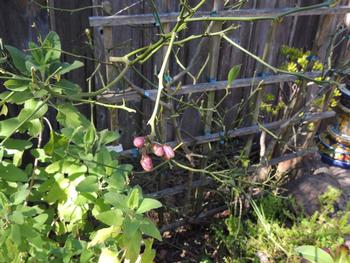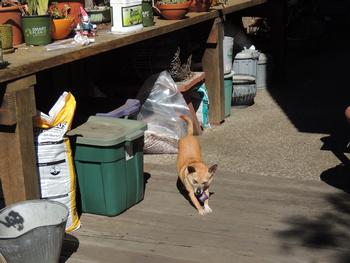Ewww… rats are everywhere!
-
Diane Lynch
-
 This stand of Mexican fan palms that haven’t been pruned provides habitat for rats, but also many species of birds and other animals, which co-exist.
This stand of Mexican fan palms that haven’t been pruned provides habitat for rats, but also many species of birds and other animals, which co-exist.
Because I have a seasonal stream that trickles all year there’s some excellent rat habitat in my garden. The Mexican fan palm is wonderful oriole habitat, but rats live up there, too. We have raccoons and skunks in the garden all the time, with occasional visits from opossums and foxes—all of these animals eat rats. It must be an infinite smorgasbord out there. This young Meyer lemon tree was completely denuded by rats. Note the blooms were the first thing the tree pushed out as it recovered.
This young Meyer lemon tree was completely denuded by rats. Note the blooms were the first thing the tree pushed out as it recovered.
The past couple of winters I’ve had plants eaten that rats have never favored before: acanthus stalks, geranium maderense leaves, and diascia were consumed right down to the roots. An entire young Meyer lemon tree was stripped of every single leaf.
So, I turned to what is called Integrated Pest Management (IPM). IPM is an ecosystem-based strategy that focuses on long-term prevention of pests or their damage by managing the ecosystem through a combination of techniques such as biological control, habitat manipulation, modification of cultural practices, and use of resistant varieties. Practices like bringing bird feeders in at night, feeding pets indoors, keeping garbage cans covered, cleaning up fallen fruit--you know the drill—I did them all. Still there was a rat problem. Unfortunately, I found out repellents aren’t very effective when I sprayed a couple of gallons of peppermint repellant to no avail. This left me to focus on habitat.Rats have coexisted with us for centuries and it’s up to us to figure out how to keep them under control by maintaining our habitats. To help remove the rat habitat within plant material and make my garden less enticing, I started fall pruning of the hydrangeas, which had bountiful summer growth and many blooms. The drought-tolerant fern that spread everywhere was thinned severely. Every piece of ivy that had grown through the fence was removed. Along with ivy, one of the top rat habitats in the Bay area, pampas grass and bamboo provide enticing cover because rats can nest in the bases.
Since I’m a packrat, no pun intended, I have no end to the stacks of pots and other things I might need someday. I have a 17’ potting bench littered with plants. Underneath, I keep potting soil, lava rock, mulch bags, all of which provide cover for rats. I’ll be getting rid of some of those pots and keeping less inventory around that provides shelter for the critters. I will be getting the mulch out of the bags and into the garden for starters. This messy potting bench has some great rat habitat underneath.
This messy potting bench has some great rat habitat underneath.Snap traps are the best way to deal with rodents that get into your house, but shouldn’t be used outside because they can catch a dog or cat paw along with animals that do good by eating rats. Glue traps are just plain cruel and can catch good guys such as spiders, snakes, lizards and birds.
Other methods like using poisons have long-term ramifications. A few years ago, WildCare in San Rafael tested animals that came into their care for rodenticide residues. The toxicology lab at UC Davis found that about 86% of those tested had rodenticides in their systems. A similar study on dogs and cats was done through veterinarians and showed similar results.
By skipping the poisons, we help natural predators such as foxes, opossums, raccoons, skunks, coyotes, bobcats and raptors such as owls and hawks to do their essential jobs and stay healthy.
A decade or so ago I read a book called “Rats”, by Robert Sullivan, which chronicles a year he spent observing rat families in an alley in New York. I came away with respect for their family structures and intelligence. UC Marin Master Gardeners Nanette Londeree and Marie Narlock have written a great primer on rats in The Leaflet, the Master Gardener newsletter available to the public: http://marinmg.ucanr.edu/Our_Projects/Leaflet/Getting_rid_of_rats_149/.
YardSmartMarin and Marin/Sonoma Vector Control have lots of information about rodents on their websites too, and someone from Vector Control will even come to your house to walk you through what to do or come to a neighborhood meeting. Guess what? If you have rats, so do your neighbors!
Photo credits: Diane Lynch



